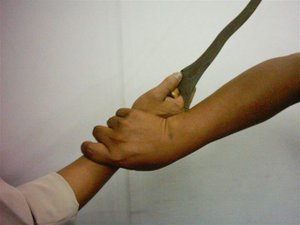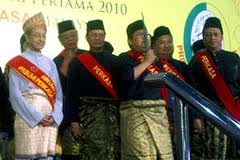With superior qualities in both mind and body, we must look to the origins that surround the fighting arts. The martial arts have always been here, shrouded in mystery and tradition, they come from the lands, history, people, environment and culture.
In the Shaolin Monastery in northern China a wandering Indian monk is said to have introduced eighteen exercises to the Chinese monks that later became known as the ‘Eighteen hands of Lo-Han,’ today’s kung fu derives from this. The Shaolin monk attire certainly reflects the Indian influences with the sandals and beads with both countries practicing Buddhism.
The Chinese elements formed the art into the flamboyant, colourful and skilful fighting method that we know today. The attractive flow of kung fu is much like their written word ‘cangy’, to write traditional cangy is an art in itself, using the inked brush to create wide and narrow lines in one continuous brush stroke, like the Chinese food it is attractive with a colourful appearance that has hidden ingredients. Kung fu students dedicate extremely long hours into their practise, much like the Chinese way of working life; there are no nine to five shifts, they can open from seven a.m. and close at midnight and some even beyond.
The Chinese calendar celebrates its new year with an animal representing each year in the cycle of the twelve animals there is the rat, ox, tiger, rabbit, dragon, snake, horse, sheep, monkey, rooster, dog and boar. Each animal has its own strengths and personality some kung fu systems have built their structure around some of these chosen animals.
The Kung fu practitioner attire is non-restricted like their flexible fighting style. Silk materials resemble the lightness of air and water with the flapping long sleeves creating the flow of waves in front of their opponent before crashing into it’s hard deadly rocks being a punch or kick.
The Chinese language be it Mandarin or Cantonese has a very rhythmic sound, from high pitch to low, its pace alters in a brief moment, this can draw comparisons to kung fu attacks that perform with high and low strikes and postures with sudden bursts of energy.
Japan’s oldest and most popular of martial arts Karate-do translate from their country quite literally, Karate was born in Okinawa. The fighting style dates back to the eighteen hundreds but it’s official introduction ‘karate-do’ (way of the empty hand) wasn’t introduced until 1912.
Mainland Japanese influences completely dominate the combat art as we know it today, the crisp white uniform reflects the purity of the Japanese way of life. Whilst other attachments to the uniform are generally black, this symbolises the balance they are striving towards in life, the Yin and Yang aspect.
This black and white element can be seen in the raw fish meal sushi, one of the most popular dishes of Japan, sushi is very simple and basic in its appearance but the lay out of the food has a philosophy that not only warrants its meaning but also aids the consuming of it. This black and white balanced theme flows through Japan not only in colour but also in its practice, the country moves as a unit oppose to individualism their strength lies in their unity. To make an executive decision on the spot is difficult for them, in triumph they are rewarded and honoured but in defeat that are immediately outcast.
Karate moves in a very linear fashion, the attacks are direct and calculated; although the art has many blocks and defensive skills there is a kamikaze undertone in their attitude.
From Thailand the old kingdom of Siam, as it was once known, a deadly fighting sport was created from military training, the art known as Muay Thai later developed in the west and was renamed kick boxing.
This 2000-year-old sport reflects the Thai people’s fighting spirit in a country surrounded with poverty disease and corruption. For those with little or no education the fastest way to earn a good wage is either to be a prostitute or become a muay thai fighter. For the many fathers that fight because of their large families the prize is nothing more than a means to put food upon the table, titles, trophy’s and glory are no substitute for cash in hand.
In the cities and shantytowns across the country, muay thai is practised, boys begin their training young and dream of becoming the local hero’s; much like western children idolising premiership football players.
In the adaptation from muay thai to the popular western style of kick boxing, many of the deadly moves endemic to the hardship of an average Thai person’s life have been removed.
The elbow and head strikes are banned because of the instant damage they can cause, most kick boxers have career’s and jobs to go to everyday and they have to turn up to work still conscious and alive!
During the seventh century Indonesia’s fighting art known as Pentjak Silat (
in Malaysia is known as a Pencak silat ) was developed on the island of Sumatra and later spread to Java blending the different influence’s met upon its journey, spawning over a hundred and fifty distinct styles that we have today.
The meaning of Pentjak Silat or Pencak Silat is ‘lighting foot work’, the art uses both armed and unarmed techniques. Many people are hypnotised by its graceful movements that relates to the culture’s dancing, known as the kembangan (flower dance). The art utilizes its movements from nature, particularly the terrain that can be an essential part of the make-up in some silat fighting systems. Animals have also influenced various styles such as the tiger and eagle they have been the kernel teachers to the warrior’s of the Indonesian Islands.

The Pentjak Silat style resembles the peoples way of working many have described the people of Indonesia as Asia’s version of the Jamaican’s, comparing the laid back approach to everyday life, this is clear to see in silat’s soft, relaxed appearance to their adversary. Their expression and body language show a fearless attitude with a calm hypnotic manner. However once the battle commences the silat player will suddenly wake from their sleeping state and will move with great speed and the commitment to finish the job hence the opponent. The Indonesian people are naturally born fighters, fighting for land and their independence from the Dutch, they named the capital of the country Jakarta (victory city). Like most developing third world countries some of the Indonesian people struggle everyday to make a living, to feed their families, be it in the city pushing karts of food products to sell or in the country planting vegetables in the fields, they work hard and show the dedication and intention that the silat fighting art demonstrates in battle. The silat attire is generally black and simple in its look as the fighter cares little for their robes as it is not the uniform that will win their battle. The trousers are cut short above the ankles, this relates to the work in the rice paddy fields to avoid getting the bottom of their garments wet everyday.
The silat practitioner’s relaxed posture is a trap to lure their opponent into the hard crushing limbs that have been constantly tried and tested over the years of training, this comparison is to the workingman that has hardened to his trade over a repeating labour for many years. Whilst other fighting arts concentrate on disabling and controlling the opponent in self-defence the silat player moves with the intention to kill and secure their existence. As martial artist’s we must understand the country, its people and their lives. A fighter may be flawless in their technique, but if they have not felt the climate or stood upon the soil of the particular country the art originates from they will never fully understand the purpose or meaning behind their art.
The content of this article could not have been written without the guidance and knowledge passed onto me by the names that follow. Special thanks to:
* Pendekar Paul Bennett
* Guru Richard Crabbe de-Bordes
* Ratih (Shirley)
* Luqman Ismail
* Sensei Robert Lawrence
This article was published in Martial Arts Illustrated magazine, 2004.






































